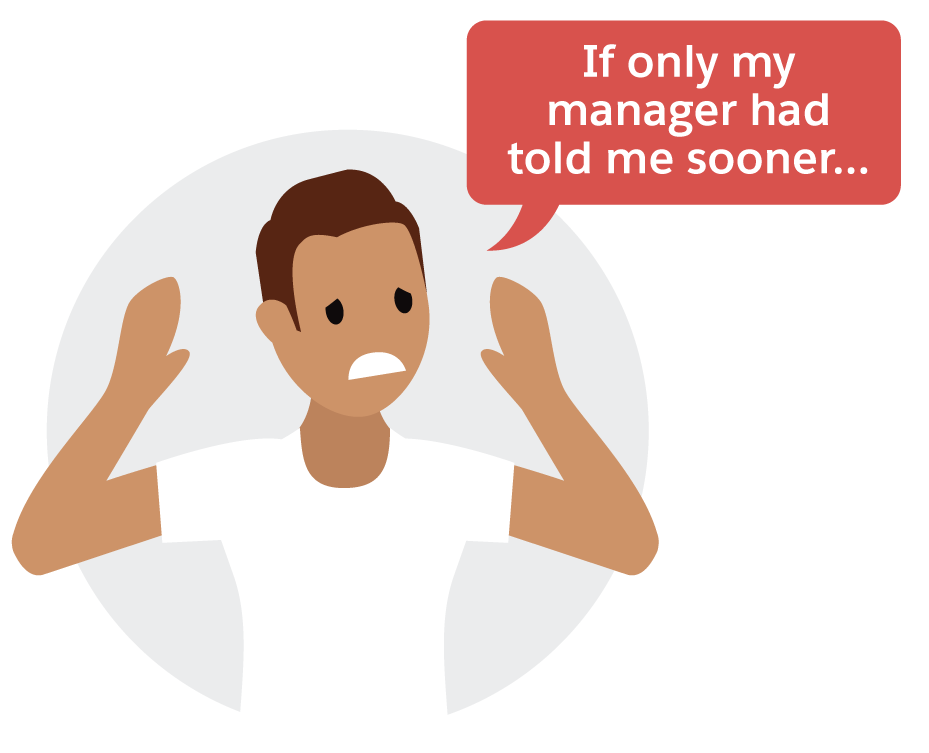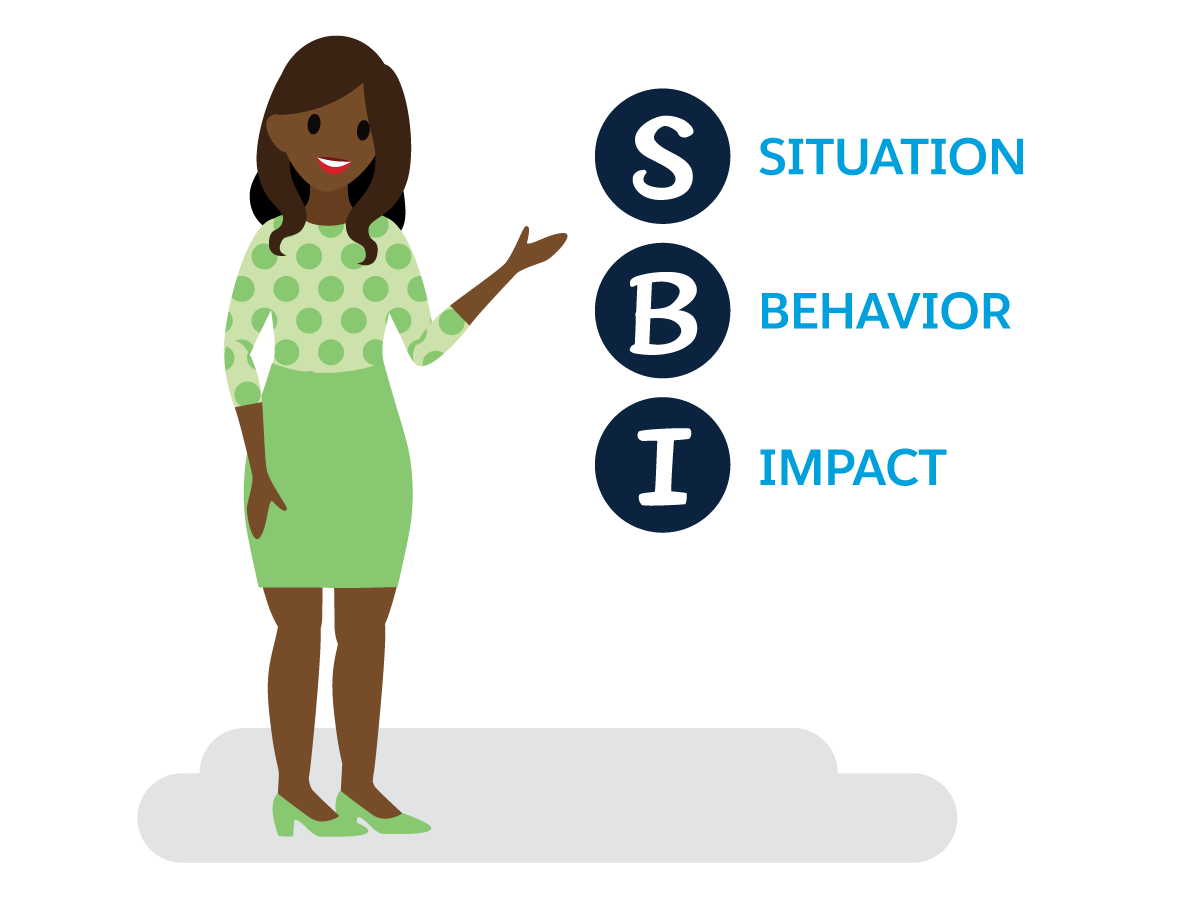Create a Feedback-Driven Culture
Learning Objectives
After completing this unit, you’ll be able to:
- Explain why feedback should be timely and ongoing.
- Deliver feedback that’s open, honest, and courageous.
- Use the SBI Model to deliver feedback.
A Culture of Feedback
Imagine that you’ve just finished a delicious lunch and you’re energized and ready for the second half of the day. Little do you know, however, that there’s a big blob of food stuck in your front teeth.
Now ask yourself this: Would you rather know about that food stuck in your teeth, or would you rather go through your afternoon meetings only to discover it later?
How about if the situation was reversed and it was your co-worker with food stuck in their teeth? Would you have the courage to tell your co-worker, or are you afraid of making that other person uncomfortable or embarrassed? Sure, it can be an awkward message to deliver, but chances are that if you’d want to know about it, they’d probably want to know about it too.
 So, what does food stuck in your teeth have to do with feedback? Well, imagine that food stuck in your teeth was actually a small little “flaw” in your work that others can see, but you’re oblivious to. And that small thing, if done differently, would make a big difference in the impact of your work? Chances are, you’d probably want to know about it.
So, what does food stuck in your teeth have to do with feedback? Well, imagine that food stuck in your teeth was actually a small little “flaw” in your work that others can see, but you’re oblivious to. And that small thing, if done differently, would make a big difference in the impact of your work? Chances are, you’d probably want to know about it.
At Salesforce, we’re striving to make it easy to talk to each other, share observations, and tell others about stuff stuck in their teeth (so to speak). We want to create an environment where giving and receiving feedback comes natural and feels like a normal part of the culture. A place where people can have courageous conversations without fearing that others will react poorly or retaliate. Staying true to our spirit of Ohana, like an extended family, we’re working toward telling it like it is, supporting each other, and holding each other accountable and on-track for success.
Starting to get a sense of what we’re striving to achieve? Let’s take a closer look at what feedback within a culture of feedback looks like.
| Feedback Looks Like This | Not This |
|---|---|
| Open, honest, and courageous |
Secretive, sugar coated, conflict averse |
| Timely and ongoing |
Delayed, saved for formal reviews |
| Actively sought and given |
Held back for fear of reactions or retaliation |
| Specific and behavior-focused |
Vague and trait-focused |
| Delivered and received with good intent |
Punitive, “gotcha” feedback, questionable motives and lack of trust, defensive or dismissive |
| Grounded in continuous improvement and the belief that people can get better |
Intelligence and talent are fixed; people can’t get better no matter how hard they try |
| Coming from a place of intellectual curiosity |
No attempt made to learn more about what one can do better |
| Multidirectional - given up, down, and across |
One-way and downward |
| Biases kept in check |
Assumptions made without testing them |
| Managers leading by example |
Managers failing to model behaviors |
In the rest of this module we’ll take a closer look at what we mean by each of these elements and how you can approach them to build a culture of feedback.
Feedback That’s Open, Honest, and Courageous
These three words—open, honest, courageous—are at the heart of what it takes to build a “feedback culture.” Open and honest ring true to our company value of transparency. Still sometimes sharing the truth—or constructive feedback—can hurt a little, right? We need to find the courage to share feedback in a way that is direct, but also respectful, so that our coworkers are more open to receiving it with dignity and grace.

To deliver feedback that’s open, honest, and courageous:
- Check your intent first: “What is my reason for giving this feedback? Is the intent to help the other person?”
- Tell your team upfront that you’ll provide ongoing feedback to everyone on the team in the spirit of continuous improvement and supporting a feedback culture.
- Be courageous and take comfort knowing that employees want, need, and thrive from receiving honest, constructive feedback.
- Share constructive feedback in private so that employees can feel safe receiving input on what they can be doing better.
- Walk the talk and ask your coworkers to also give you open and honest feedback, especially on what you can do better.
- Bring your teammate or direct report in on creating a solution to the issue at hand.
- Write down specific observations during or after an event so that you’ll remember and be prepared to discuss them when the time is right.
- Send a quick email and set-up a time to follow up and share the feedback on what you observed.
Feedback That’s Timely and Ongoing
Timely and ongoing feedback is...well, given in a timely manner and an ongoing basis. Such a simple concept, but the devil’s in the execution.
Think about it. How often do you intend to give that constructive feedback right after that presentation but you’re in a hurry and can’t deliver it right there? Maybe you want to deliver your feedback in private and you wait till the next one-on-one. And then that one-on-one gets cancelled, your employee goes out on vacation, that big presentation is due, and two to three weeks have gone by before you’ve shared your observations. By then you and your employee might not even remember what happened—and sharing feedback that late just isn’t fair to anyone.
 Providing timely and ongoing feedback helps ensure that your employees are clear on:
Providing timely and ongoing feedback helps ensure that your employees are clear on:
- How they’re performing
- What’s expected of them
- The priorities to focus on
Given the pace of work and frequency of change, your employees want and need fast feedback that can allow them to make quick adjustments and learn and grow. Putting off feedback till that next meeting, the mid-year review, or worse yet, the annual review will lead to decreases in engagement, productivity, and overall performance.
To make sure that feedback is timely and ongoing:
- Write down your observations so that you’ll remember them and be prepared to deliver them accurately when the time comes.
- Provide feedback as close in time to the event as possible, ideally within 48 hours.
- Make feedback a routine part of your check-ins with your team.
Feedback That’s Actively Sought and Given

It might sound like an obvious statement, but at Salesforce, we believe everyone, regardless of experience or job level, has the opportunity to learn, grow, and improve. And the only way we can do that is if we build our “feedback muscle” by asking for and giving feedback on a regular basis.
How often should you ask for feedback? There’s no hard and fast rule, especially when asking for feedback comes from a place of wanting to get better at your job. In fact, studies have shown that leaders who actively seek out feedback are ranked more effective than those who don’t.
What about giving feedback? Again, it’s not the quantity, but the quality of the feedback. Delivering it in an open, honest, courageous, specific, and behavior-focused way increases your chances of the feedback being well received.
To make giving and receiving feedback a norm:
- Set a personal goal or challenge for your team to give, and be open to receiving, feedback more often.
- Act as a role model by sharing stories of feedback you’ve received and how it has helped your performance and career.
- Ask for feedback from your employees in your one-on-ones, such as “What can I be doing better to support you?”
- Before giving feedback, ask for permission to increase the receiver’s readiness and receptiveness.
Feedback That’s Specific and Behavior Focused
Ever receive feedback that you weren’t sure what to do with? Maybe you didn’t understand the context, what you did right or wrong, or why the feedback was being brought to your attention in the first place?
We want to help give you some tools so that you feel comfortable and confident in going straight to the source when it comes to your feedback.
This is where feedback that’s specific and behavior-focused can help. In the Giving and Receiving unit in the Coaching & Feedback module, we talked about a model called SBI which stands for Situation, Behavior, and Impact. It’s a great model for framing both positive or constructive feedback. When done right it leaves little room for misinterpretations.

Here’s a refresher on SBI.
|
S
|
Situation |
Open the conversation by referencing a specific situation or context |
|
B
|
Behavior |
Then describe the person’s behavior |
|
I
|
Impact |
Finally, explain the impact that the behavior has on the person, the team, the business, or customers |
You can learn more about SBI in the Coaching & Feedback module.
Even if you master the SBI model, don’t get formulaic in how you deliver the message. There’s another person on the other end of your message and you want to make sure they believe—and feel—that your intentions are positive—that you’re truly interested in helping them learn and grow.
SBI is a good start, but being mindful of your intent can make the giving and receiving of feedback even more effective. We’ll explore intent and more in the next unit.

Now you’re starting to understand how being open and timely are key, along with having your feedback follow the SBI model. But a big part of making your company feedback-driven is seeking out and giving feedback regularly. We’ll discuss how to do that in the next unit, starting with setting your intention.
